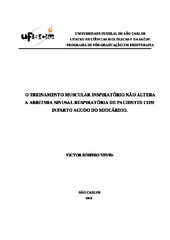| dc.contributor.author | Neves, Victor Ribeiro | |
| dc.date.accessioned | 2016-06-02T20:19:07Z | |
| dc.date.available | 2008-05-09 | |
| dc.date.available | 2016-06-02T20:19:07Z | |
| dc.date.issued | 2008-02-29 | |
| dc.identifier.citation | NEVES, Victor Ribeiro. O treinamento muscular inspiratório não altera a arritmia
sinusal respiratória de pacientes com infarto agudo do
miocárdio. 2008. 87 f. Dissertação (Mestrado em Ciências Biológicas) - Universidade Federal de São Carlos, São Carlos, 2008. | por |
| dc.identifier.uri | https://repositorio.ufscar.br/handle/ufscar/5223 | |
| dc.description.abstract | Introduction: Respiratory sinus arrhythmia (RSA) has been used for assessment the cardiac modulation autonomic and measured by ratio expiration/inspiratory (E/I) and inspiration/expiration heart rate variation (∆IE). The RSA is lower in patients with acute myocardial infarction. Objective: To evaluate the effect of inspiratory muscle training (IMT) on the RSA magnitude and maximal inspiratory pressure (PImax) in patients with AMI after 6 days of physiotherapeutic intervention during hospitalized period. Methodology: Thirty three patients were divided in two groups: 19 patients of treatment group (TG) (14 males, 5 females, aged 50±9 years) who underwent the cardiovascular physiotherapy and 14 patients of control group (CG) (11 males, 3 females, aged 52±11 years) without physiotherapy. The intervals RR of electrocardiogram were obtained by Polar S810i during the RSA test on the 1st and 6th days. It was used to calculate the heart rate variability in the time (TD) and in the frequency domain and the RSA index. The PImax was obtained by manovacuometer on the 2nd and 6th days. The IMT (3x, 10 forced inspiration, 40% PImax, for 3 seconds each) was done from the 2nd to 6th days. Two-way ANOVA, Paired-t Test, Chi-square test and Pearson s correlation (p<0.05) were used. Results: In the TD, the TG showed higher values than the CG for the SDNN (1st day 58±37 and 33±23ms; 6th day 49±20 and 32±17ms, respectively) and for the RMSSD (1st day 40±32 e 21±18 ms; 6th day 33±18 and 22±14ms, respectively). The ∆IE decreased significantly for the TG (12,8±7,5 to 9,9±4,8 bpm) and for the CG (10,8±5,3 to7,5±3,4 bpm). For the TG, the PImax increased (p<0,05) from 78±25 to 101±25. Conclusion: The IMT increased the PImax, although it did not modify the ASR magnitude in patients with acute myocardial infarction. | eng |
| dc.description.sponsorship | Financiadora de Estudos e Projetos | |
| dc.format | application/pdf | por |
| dc.language | por | por |
| dc.publisher | Universidade Federal de São Carlos | por |
| dc.rights | Acesso Aberto | por |
| dc.subject | Fisioterapia | por |
| dc.subject | Variabilidade da freqüência cardíaca | por |
| dc.subject | Infarto agudo do miocárdio | por |
| dc.subject | Treinamento muscular inspiratório | por |
| dc.subject | Pressão inspiratória máxima | por |
| dc.subject | Arritmia sinusal respiratória | por |
| dc.title | O treinamento muscular inspiratório não altera a arritmia
sinusal respiratória de pacientes com infarto agudo do
miocárdio | por |
| dc.type | Dissertação | por |
| dc.contributor.advisor1 | Catai, Aparecida Maria | |
| dc.contributor.advisor1Lattes | http://genos.cnpq.br:12010/dwlattes/owa/prc_imp_cv_int?f_cod=K4793978Y6 | por |
| dc.description.resumo | Introdução: A arritmia sinusal respiratória (ASR) tem sido utilizada para estudar a modulação autonômica cardíaca sendo avaliada pelos índices expiração/inspiração (E/I) e variação da freqüência cardíaca inspiração-expiração (∆IE). A ASR encontra-se reduzida em pacientes com infarto agudo do miocárdio (IAM). Objetivo: Avaliar o efeito do treinamento muscular inspiratório (TMI) na magnitude da ASR e da pressão inspiratória máxima (PImax) de pacientes com IAM após 6 dias de intervenção fisioterapêutica no período intra-hospitalar. Metodologia: Trinta e três pacientes foram divididos em: grupo tratado (GT) com 19 pacientes (14 homens, 5 mulheres, idade 50±9 anos) que foram submetidos a fisioterapia cardiovascular associado com o TMI e o grupo controle (GC) com 14 pacientes (11 homens, 3 mulheres, idade 52±11 anos) sem fisioterapia. Os intervalos RR do eletrocardiograma coletados por meio de um polar S810i, durante uma manobra para acentuar a ASR, realizada na posição supina no 1° e 6° dias. Foram calculados a variabilidade da freqüência cardíaca no domínio do tempo (DT) por meio dos índices RMSM e RMSD dos intervalos R-R em ms e da freqüência (DF) e os índices da ASR. A PImax foi obtida por meio de um manuvacuômetro no 2° e 6° dia e o TMI (3x de 10 inspirações forçadas a 40% da PImax por 3 segundos cada) realizado do 2° ao 6° dia. Análise estatística: Foram usados ANOVA two way de medidas repetidas, teste t pareado, teste qui-quadrado e correlação de Pearson (p<0,05). Resultados: No DT, o GT apresentou comparativamente ao GC, valores superiores de RMSM (1º dia 58±37 e 33±23 ms; 6º dia 49±20 e 32±17ms) e de RMSSD (1º dia 40±32 e 21±18ms; 6º dia 33±18 e 22±14ms), respectivamente. O ∆IE diminuiu (p<0,05) do 1º para o 6º dia no GT (12,8±7,5 para 9,9±4,8 bpm) e no GC (10,8±5,3 para 7,5±3,4 bpm). No GT, a PImax aumentou (p<0,05) de 78±25 para 101±25. Conclusão: O TMI aumentou a PImax, porém, não modificou a magnitude da ASR no IAM. | por |
| dc.publisher.country | BR | por |
| dc.publisher.initials | UFSCar | por |
| dc.publisher.program | Programa de Pós-Graduação em Fisioterapia - PPGFt | por |
| dc.subject.cnpq | CIENCIAS DA SAUDE::FISIOTERAPIA E TERAPIA OCUPACIONAL | por |
| dc.contributor.authorlattes | http://lattes.cnpq.br/3476550607994320 | por |
